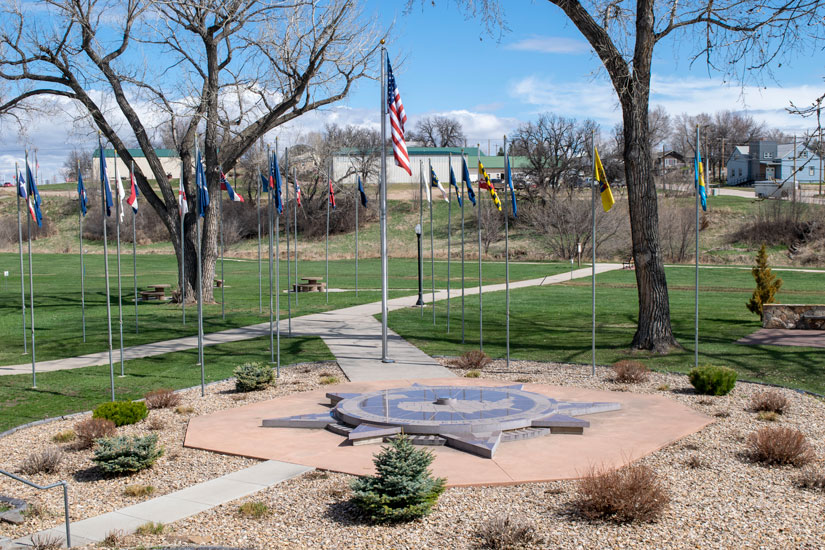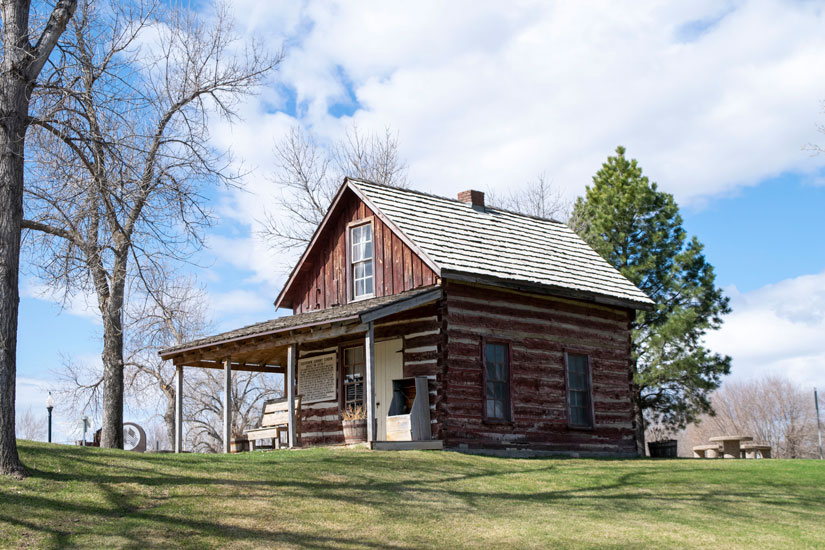Founded over 65 years ago in 1955, the Tri-State Museum was created to house a collection from Mrs. Roy Williams of Hammond, Mont. After her husband passed away, Mrs. Williams realized the value of the collection and contacted local businessmen and leaders, offering the items to them.
Locals and staff refer to the museum as a part of the “complex,” which includes the original historic Johnny Spaulding Cabin, Center of the Nation monument (the real center of the nation is 21 miles outside of Belle Fourche), visitor center, and museum. The complex also has beautiful rolling lawns for picnics and games, Frisbee golf, and is home to the Tri-State Performers, a musical theatre troupe that puts on two to three productions each year.

Today, the museum has a series of permanent exhibits ranging from tribal artifacts and dolls to military uniforms and other items. Featured exhibits include:
- The industry exhibit tells the story of past businesses such as the pickle factory, broom factory, sugar plant, flour milling, bentonite—and how, in many ways, each industry impacted the other.
- The mercantile exhibit features vintage glass-topped cases with items such as hats, gloves, clothing, housewares, and toys, as well as newly added bags and boxes of “merchandise” for visitors to examine.
- The law exhibit salutes long-ago lawyers of the area with photos, law books, a desk, and vintage items such as gavels, signage, and typewriters.
- The freshly painted and rearranged medicine exhibit has been made more accessible to visitors and includes medical equipment, a pharmacy chest, and images of physicians from days gone by.
- The military exhibit includes tiered cases of photos, artifacts, and uniforms from those who served in wars from World War II to today.
- The paleontology exhibit includes fossilized bones from a brontosaurus, thescelosaurus, triceratops, edmontosaurus, mammoths, and a cast of a T-Rex skull. These fossilized finds are all from the Tri-State area. Likewise, the geology and archaeology exhibits include rocks, fossils, and artifacts found in this area. There is also an archaeological dig box for kids to explore and in the summer and an outdoor gold panning station.
- The rodeo exhibit features the history of the sport, women of early rodeo and the Black Hills Roundup, and rodeo queens.
- The ranching exhibit features a map of noted ranches from the area and vintage metal implements used in ranch work. The cattle outfit exhibit tells the story of cattle outfits from the late 19th century and includes a book that lists the names of who worked in the outfits so visitors can see if there is a cowboy in their family tree.
- The saloon exhibit has photos and information about early saloon keepers in the area such as Dan Roberts, as well as artifacts including whiskey jugs and a table where visitors can sit and play cards as old-time saloon visitors did.
With Belle Fourche being close to the border, the Tri-State Museum got its name from the coverage it provides. With items and history from Wyoming, Montana, and South Dakota, the museum documents three states from the surrounding area. It has become a point of attraction and history for all three states.
“The mission of the Tri-State Museum is to collect, document, preserve, and interpret the historic materials and ideas from the early settlement of the Tri-State area, including the corners of South Dakota, Montana, and Wyoming; to tell the stories of the early settlers and preserve them for the next generations of this area; and to share these materials and stories with our visitors.”
Director of the Tri-State Museum and Visitor Center, Kristi Thielen, says, “We make every effort to be as approachable as possible by providing information that is meaningful through storytelling.” In addition to the traditional exhibits, the museum offers hands-on experiences for adults and children whenever possible, like activity or discovery tables and boxes. Offering both a traditional approach to the museum and the hands-on activities creates an opportunity for guests to learn about the real west, according to Kristi. “Both the historic west and the west of today, which is equally important and viable,” she adds.
With so many eyes on the exhibits, the favorites seem to vary from crowd to crowd. Locals tend to love the industry exhibit while visitors who aren’t familiar with the culture of the west enjoy the rodeo, ranching, and salooning exhibits best. Because those sections tend to be dramatized parts of the west, they capture visitors’ attentions and imaginations better.
“The Johnny Spaulding Cabin is a historic two-story cabin, and is only one of two left in the United States.”

If you are rolling into town at the beginning of the month, every first Saturday the museum hosts a brunch with a speaker. The topics range from history, science, and culture to railroads, beekeeping, birds, and more! Some months honor themes from holidays. For example, this October, they have the history and culture of Halloween planned for the Saturday brunch. Events that are held at the museum do cost a small entrance fee ranging from $2-$5 for non-members.
At this time, the organization is using the closure due to the pandemic as a chance to refresh and redo their look. “We are taking this opportunity to completely redo everything so that the exhibits will feel fresh, interesting, and include brighter colors,” Kristi says.
Looking forward to their visitors, the museum plans on having a Grand Reopening event in early summer. On average, the museum sees almost 20,000 visitors a year. According to Kristi, guests come from both near and far to check it out. Visitors from all 50 states and more than 10 foreign countries have checked in at the museum throughout the years. Did we mention that admission is free?
Learn more at www.thetristatemuseum.com.

